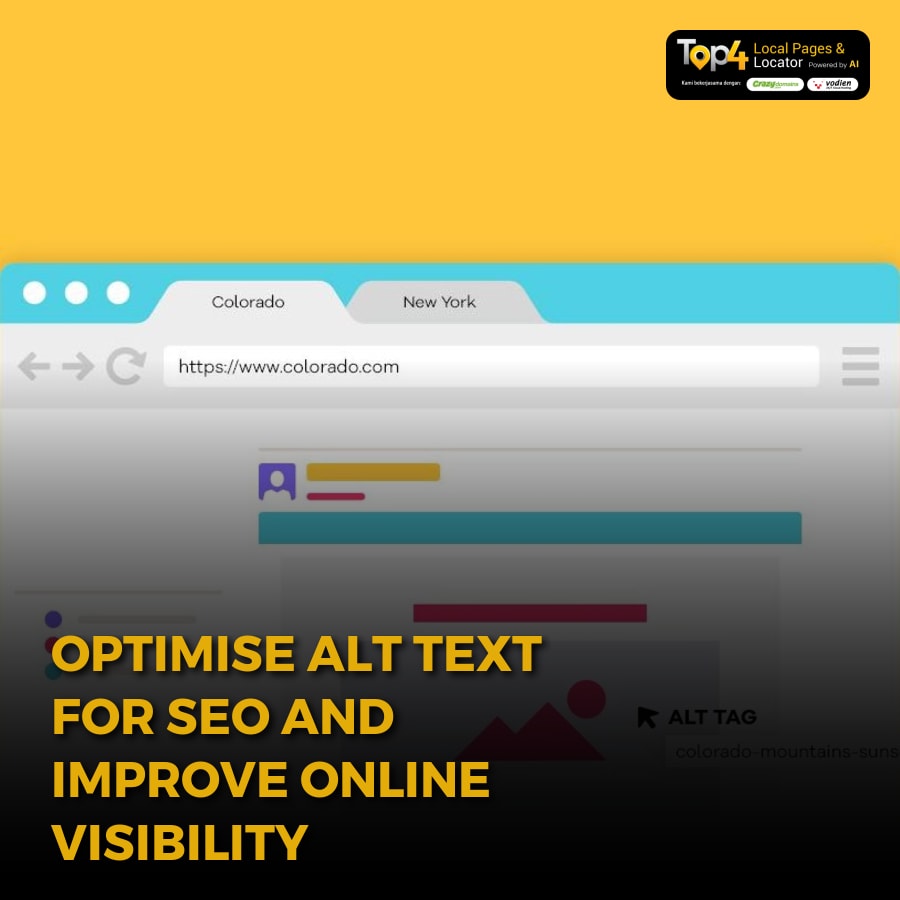How do search engines "see" the images on your website? Many businesses overlook the importance of alt text, a simple yet powerful attribute that can make a big difference in your online visibility.
Alt text, short for "alternative text," is a descriptive text attribute added to images on web pages. It serves as a textual alternative for those who cannot see the image and provides valuable information to search engines, but it also enhances accessibility for users who rely on screen readers. As a local business or franchise owner, understanding how to use alt text effectively can provide you with a competitive edge in the online marketplace.
Understanding Alt Text and Its Importance
Alt text is like a hidden caption for your images. It's a short text description that tells search engines and visually impaired users what the image is all about. When an image fails to load, the alt text is displayed instead, ensuring that visitors still understand the content. But alt text is more than just a backup for broken images; it's a valuable tool for improving your website's SEO. Search engines rely on alt text to understand the content of images, which can boost your website's visibility in search results. By providing clear and descriptive alt text, you're not only making your website more accessible but also helping search engines understand and rank your content more effectively.
How to Write Effective Alt Text
Writing effective alt text is a balance of being concise, descriptive, and relevant. Here are some key tips:
- Be specific and descriptive: Describe the image as accurately as possible, providing context and details that are relevant to the surrounding content.
- Keep it concise: Aim for alt text that is no more than 125 characters, as this is the limit for most screen readers.
- Use keywords naturally: Incorporate relevant keywords where appropriate, but avoid keyword stuffing. Focus on providing a natural and accurate description of the image.
- Don't start with "image of" or "picture of": Screen readers automatically announce that it's an image, so there's no need to include this in your alt text.
- Provide context for complex images: If the image contains complex information, such as a chart or graph, provide a more detailed description in the surrounding text or link to a separate page with a full explanation.
- Consider the image's purpose: Think about why you're including the image and how it relates to your content. This will help you write alt text that accurately reflects its purpose.
Examples of Effective Alt Text
Let's look at some examples to illustrate how to write effective alt text:
- Instead of: "Image of a woman drinking coffee"
- Write: "Woman sitting at a table, enjoying a cup of coffee and reading a book."
- Instead of: "Picture of a dog"
- Write: "Golden Retriever puppy playing fetch in a park."
- Instead of: "Product image"
- Write: "[Product name] – [brief product description]."
The Role of AI in Alt Text Creation
Artificial intelligence (AI) is making waves in many fields, and SEO is no exception. With advancements in image recognition, AI can now analyse images and generate alt text suggestions, saving you time and effort. But while AI can be a helpful tool, it's important to remember that it can't fully replace human judgement.
The Benefits of Using AI for Alt Text:
- Efficiency: AI can quickly analyse large volumes of images and generate alt text suggestions, speeding up the process, especially for websites with extensive image libraries.
- Improved accuracy: AI algorithms are constantly learning and improving, and they can often identify objects and details in images that humans might miss.
- Consistency: AI can help ensure consistency in your alt text across your website, which is important for both accessibility and SEO.
The Limitations of AI for Alt Text:
- Lack of context: AI may struggle to understand the context of an image and its purpose on the page. This can lead to inaccurate or irrelevant alt text.
- Difficulty with abstract concepts: AI may have difficulty describing abstract images or conveying emotions and nuances that are important for understanding the image's meaning.
- Potential for bias: AI models are trained on data, and if that data contains biases, the generated alt text may reflect those biases.
How to Use AI Effectively for Alt Text:
- Choose a reliable AI tool: Several tools are available, each with its own strengths and weaknesses. Research and select a tool that best suits your needs.
- Review and edit AI suggestions: Never blindly accept AI-generated alt text. Always review and edit the suggestions to ensure accuracy, relevance, and clarity.
- Provide context to the AI: Some tools allow you to provide additional information about the image, such as its purpose or context on the page. This can help the AI generate more accurate alt text.
- Combine AI with human expertise: The best approach is to use AI as a starting point and then refine the alt text with human insights and judgement.
AI can be a valuable tool for creating alt text, but it's important to use it wisely. By combining AI with human expertise, you can streamline your workflow while ensuring your alt text is accurate, relevant, and effective.
How Alt Text Improves SEO
While alt text primarily serves an accessibility function, it also plays a significant role in your website's search engine optimization (SEO). Search engines may not have eyes, but they can still "understand" images with the help of alt text.
How Alt Text Improves SEO:
- Provides context for images: Alt text helps search engines understand the subject matter and relevance of your images, allowing them to index your images properly and associate them with relevant keywords.
- Improves visibility in image search: When users search for images on Google or other search engines, your images are more likely to appear in the results if they have relevant and descriptive alt text.
- Boosts overall page relevance: Search engines consider the content of your entire page, including images, when determining its relevance to a search query. Well-written alt text can contribute to the overall relevance of your page, potentially improving its ranking.
- Increases website traffic: By improving your visibility in image search and general search results, alt text can drive more traffic to your website.
- Enhances user experience: While not a direct SEO factor, alt text can improve the user experience by providing context when images fail to load. A positive user experience can indirectly benefit your SEO by reducing bounce rates and increasing engagement.
Tips for Using Alt Text for SEO:
- Be specific and descriptive: Accurately describe the image and its context within the page.
- Use relevant keywords: Incorporate keywords that are relevant to the image and the page's overall topic, but avoid keyword stuffing.
- Keep it concise: Aim for alt text that is concise and to the point, ideally under 125 characters.
- Write in a natural tone: Avoid writing alt text that sounds robotic or forced. Use natural language that a human would use to describe the image.
By incorporating these tips into your alt text strategy, you can leverage the power of images to improve your website's SEO and drive more organic traffic.
Common Mistakes to Avoid with Alt Text
While alt text is a relatively simple concept, there are some common mistakes that can hinder its effectiveness and even harm your SEO efforts. Here are a few pitfalls to avoid:
1. Vague or Generic Alt Text
Imagine an image of a person hiking in a mountain range. Alt text that simply says "person hiking" is too generic. It doesn't provide enough context or detail for search engines or users with visual impairments. Instead, aim for something more descriptive, like "a hiker with a backpack trekking through a scenic mountain trail."
2. Missing Alt Text
Leaving the alt text field blank is a missed opportunity. Without alt text, search engines have no way of understanding the content of your images, and visually impaired users miss out on crucial information. Always include alt text, even if it's a simple description.
3. Overly Long Alt Text
While it's important to be descriptive, avoid writing lengthy alt text that reads like a novel. Aim for concise descriptions that focus on the most important details. Screen readers typically have a limit of around 125 characters, so keep your alt text within that range.
4. Keyword Stuffing
Don't try to cram as many keywords as possible into your alt text. This practice, known as keyword stuffing, can actually harm your SEO. Search engines prioritize natural and relevant language, so focus on writing descriptive alt text that accurately reflects the image and incorporates keywords naturally.
5. Redundant Information
If the surrounding text already describes the image in detail, there's no need to repeat that information in the alt text. Instead, focus on providing unique and complementary information that adds value for users and search engines.
6. Using Alt Text for Decorative Images
If an image is purely decorative and doesn't add any meaningful content to the page, you can use an empty alt attribute (alt=""). This tells screen readers to ignore the image, improving the user experience for those who rely on assistive technologies.
By avoiding these common mistakes and following best practices for alt text, you can ensure your images are contributing positively to your website's accessibility, user experience, and SEO.
Alt Text as Part of Your Overall SEO Strategy
Incorporating alt text into your broader SEO strategy can yield significant results. Start by auditing your existing images to ensure they have descriptive alt text. For new content, make alt text a standard part of your image optimisation process. Consider it an extension of your overall content strategy, where each image serves a purpose and contributes to your site’s visibility. Additionally, educate your team about the importance of alt text in SEO and user experience. By fostering an understanding of these principles, you can create a more effective marketing approach that resonates with your audience.
Conclusion
Alt text is a vital element of your digital marketing strategy that can greatly impact your local business's online success. By crafting effective alt text, utilising AI responsibly, and integrating it into your overall SEO strategy, you can enhance your website's visibility and accessibility. Avoid common mistakes to ensure that your images not only look appealing but also serve their purpose in driving traffic and engagement.
At Top4 Marketing, our expertise can help you craft a local marketing plan that aligns with your business goals and local community needs. Let us assist you in maximising your online strategy. Visit Top4 Marketing blog for more insights to elevate your business to new heights. Contact us today and start your journey towards local marketing success.


 SAUDI ARABIA
SAUDI ARABIA

























